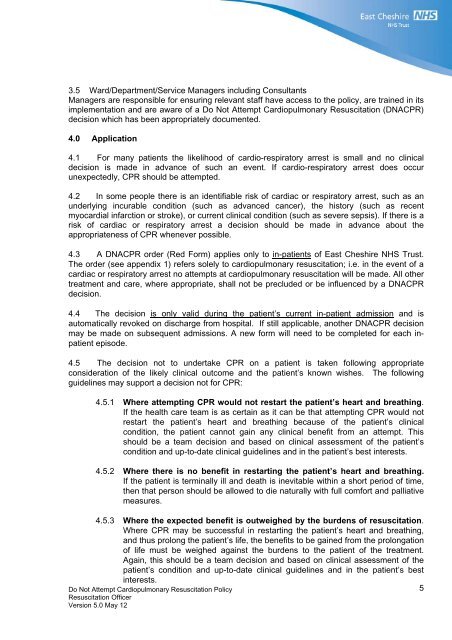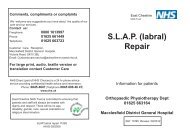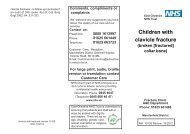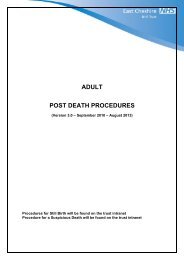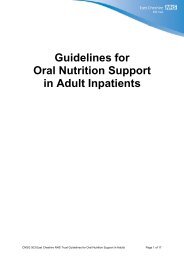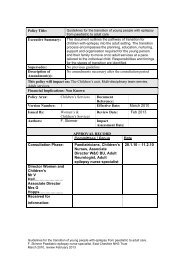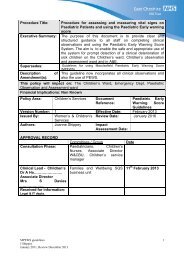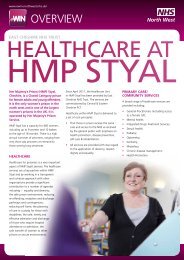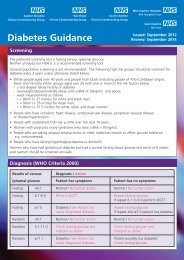Do Not Attempt Cardiopulmonary Resuscitation 1669.pdf
Do Not Attempt Cardiopulmonary Resuscitation 1669.pdf
Do Not Attempt Cardiopulmonary Resuscitation 1669.pdf
- No tags were found...
You also want an ePaper? Increase the reach of your titles
YUMPU automatically turns print PDFs into web optimized ePapers that Google loves.
3.5 Ward/Department/Service Managers including ConsultantsManagers are responsible for ensuring relevant staff have access to the policy, are trained in itsimplementation and are aware of a <strong>Do</strong> <strong>Not</strong> <strong>Attempt</strong> <strong>Cardiopulmonary</strong> <strong>Resuscitation</strong> (DNACPR)decision which has been appropriately documented.4.0 Application4.1 For many patients the likelihood of cardio-respiratory arrest is small and no clinicaldecision is made in advance of such an event. If cardio-respiratory arrest does occurunexpectedly, CPR should be attempted.4.2 In some people there is an identifiable risk of cardiac or respiratory arrest, such as anunderlying incurable condition (such as advanced cancer), the history (such as recentmyocardial infarction or stroke), or current clinical condition (such as severe sepsis). If there is arisk of cardiac or respiratory arrest a decision should be made in advance about theappropriateness of CPR whenever possible.4.3 A DNACPR order (Red Form) applies only to in-patients of East Cheshire NHS Trust.The order (see appendix 1) refers solely to cardiopulmonary resuscitation; i.e. in the event of acardiac or respiratory arrest no attempts at cardiopulmonary resuscitation will be made. All othertreatment and care, where appropriate, shall not be precluded or be influenced by a DNACPRdecision.4.4 The decision is only valid during the patient’s current in-patient admission and isautomatically revoked on discharge from hospital. If still applicable, another DNACPR decisionmay be made on subsequent admissions. A new form will need to be completed for each inpatientepisode.4.5 The decision not to undertake CPR on a patient is taken following appropriateconsideration of the likely clinical outcome and the patient’s known wishes. The followingguidelines may support a decision not for CPR:4.5.1 Where attempting CPR would not restart the patient’s heart and breathing.If the health care team is as certain as it can be that attempting CPR would notrestart the patient’s heart and breathing because of the patient’s clinicalcondition, the patient cannot gain any clinical benefit from an attempt. Thisshould be a team decision and based on clinical assessment of the patient’scondition and up-to-date clinical guidelines and in the patient’s best interests.4.5.2 Where there is no benefit in restarting the patient’s heart and breathing.If the patient is terminally ill and death is inevitable within a short period of time,then that person should be allowed to die naturally with full comfort and palliativemeasures.4.5.3 Where the expected benefit is outweighed by the burdens of resuscitation.Where CPR may be successful in restarting the patient’s heart and breathing,and thus prolong the patient’s life, the benefits to be gained from the prolongationof life must be weighed against the burdens to the patient of the treatment.Again, this should be a team decision and based on clinical assessment of thepatient’s condition and up-to-date clinical guidelines and in the patient’s bestinterests.<strong>Do</strong> <strong>Not</strong> <strong>Attempt</strong> <strong>Cardiopulmonary</strong> <strong>Resuscitation</strong> Policy5<strong>Resuscitation</strong> OfficerVersion 5.0 May 12


